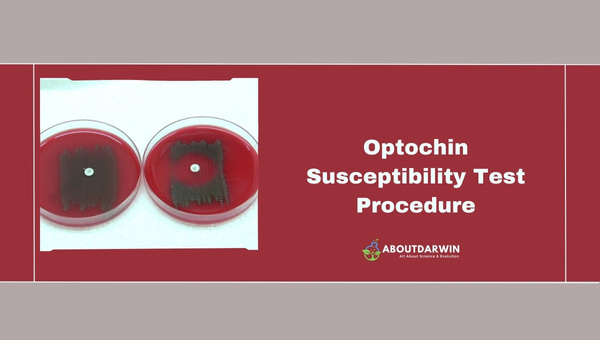Physical Address
304 North Cardinal St.
Dorchester Center, MA 02124
Identifying Streptococcus pneumoniae accurately plays a vital role in medical diagnostics. When it comes to the detection and identification of this bacterial species, one of the most effective tools at our disposal is the Optochin Susceptibility Test.
To gain a better understanding of this crucial diagnostic process, let’s delve into what exactly Optochin Susceptibility is, how it works to identify Streptococcus pneumonia and clarify its significance within medical microbiology.
By doing so, we hope to shed light on some intricate aspects of healthcare that often go unnoticed but play an enormous part in keeping us healthy.
Contents
In the realm of medical and biological testing, a crucial tool that I often come across is the Optochin Susceptibility test. This simple yet effective method has opened doors in the identification of sly little bacteria, particularly Streptococcus pneumoniae.

In essence, it’s a test that utilizes a unique compound named ‘Optochin’. This compound has an intriguing property—it can inhibit bacterial growth under certain conditions. By observing this behavior in our samples, we can reliably identify whether specific bacteria are present—specifically our culprit for today: Streptococcus pneumonia.
The term ‘Optochin Susceptibility’ refers to how susceptible certain bacteria are to optochin – an antibacterial agent. Significant here is our focus bacterium – Streptococcus pneumonia, which exhibits high sensitivity to optochin.
When exposed to this compound in a lab setting, if it’s indeed S. pneumoniae causing trouble, they end up forming distinct inhibition zones – leading us right to them!
The role of Optochin is given below :
Sources: Multiple scientific studies support these points, for example, one notable 2001 research paper in the Journal of Clinical Microbiology.
Also Read: How Do Family Trees Work? Unraveling The Intricacies
The Optochin susceptibility test procedure is a detailed but essential method for accurately identifying Streptococcus pneumonia.

It involves precise steps ranging from safe sample collection and proper execution of the test to careful interpretation of results.
Some tests need to be performed for collecting samples:
This is how the test is performed :
Remember, folks always follow guidelines and safety procedures while conducting these tests!
After carrying out an Optochin Susceptibility test, it’s all about reading the signs produced by our targeted bacteria. Within 18 to 24 hours of incubation, we search for a clear indication—what’s known as a ‘zone of inhibition,’ encircling the optochin disk.
If Streptococcus pneumoniae is present, the inhibition zone’s diameter typically exceeds 14mm, affirming its susceptibility to optochin. In case our perp is indeed S. pneumoniae—the mighty blow dealt by optochin becomes evident in this tell-tale circle that separates them from rest.
However, it isn’t always a direct “caught red-handed” situation. For instances where we find zones smaller than 14mm or no visible impact on growth—our bacterium shows resistance to optochin. It signals toward different bacterial species altogether, requiring more detective work.
Some points are given that you should see once:
| LIMITATIONS OF OPTOCHIN TESTING | KEY FACTORS AFFECTING ACCURACY |
|---|---|
| Non-specific inhibition: Other non-pneumococcal species of streptococcus, such as S.mitans and S.orails, can also display optochin sensitivity, leading to false positives. | Sample mishandling: Mismanagement or contamination of the sample can result in inaccurate test results. |
| Variable growth conditions: Variations in CO2 concentrations and incubation temperature can impact the accuracy of the optochin test. | Inappropriate Incubation conditions: Failure to maintain optimal temperature (35-37°C) and CO2 levels (5%) during incubation may affect interpretation. |
| Misinterpretation due to similarities with other bacteria: Certain strains of Viridans group streptococci may show similar characteristics, leading to incorrect identification. | Poor quality control measures: Ensuring strict quality standards for Optochin disks is crucial as faulty or outdated ones can compromise test validity. |
Also Read: Unlock DNA Discoveries: Free DNA Upload Websites Guide
Aside from an Optochin Susceptibility Test, other common methods for identifying Streptococcus pneumoniae include a Quellung test, Bile Solubility test, and Gram Stain with a Spinal Fluid Culture.
No, performing this test requires specialized training and equipment. It’s typically conducted in lab settings under professional supervision.
The Optochin Susceptibility Test is considered highly reliable, given that it creates distinct zones of inhibition against S. pneumoniae. However, it should be combined with other tests to enhance diagnostic accuracy.
Safety measures include using personal protective equipment like gloves and lab coats; handling samples, bacteria & reagents responsibly; practicing proper waste disposal; and sanitizing work areas before and after the procedure.
Also Read: What is My Cousin’s Cousin to Me? Unraveling Family Ties
Throughout the article, we delved into understanding Optochin Susceptibility testing—a truly fascinating diagnostic tool in our arsenal. Its ingenious strategy of exploiting the sensitivity of Streptococcus pneumoniae to this peculiar compound, Optochin, adds another layer of conviction to our diagnostic procedures.
As we navigate through the complexities and challenges inherent in diagnosing infectious agents like S. pneumoniae, having tools like the Optochin Susceptibility test offers us evidence-based confidence.
Despite their limitations and variable factors that could influence the results, these tests provide invaluable insights that help us steer therapeutic decisions toward success.